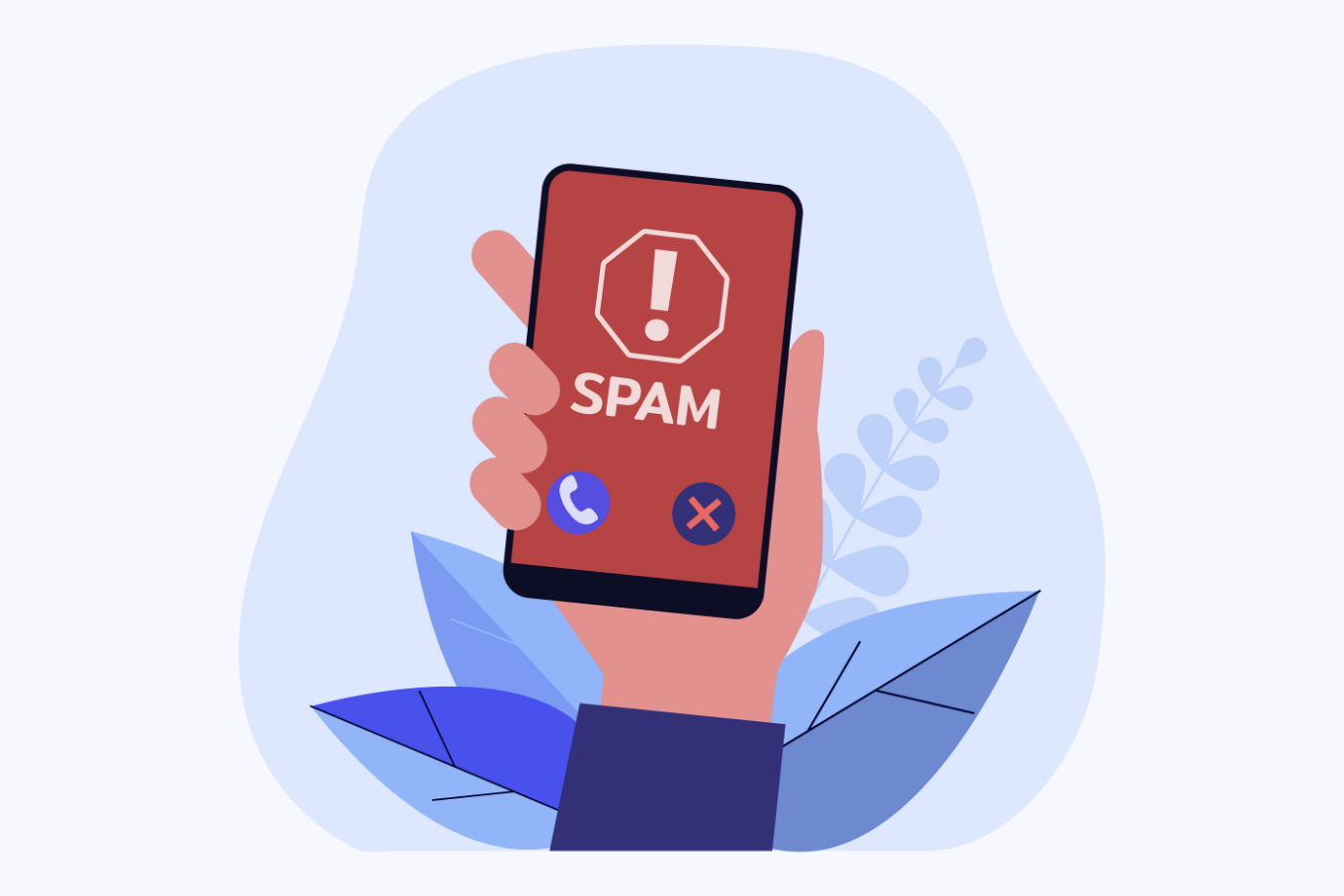Every telecalling agent knows the feeling: you dial a prospect's number, eagerly say, [Hello, I am calling from XYZ company], and before you can even finish, the phone call ends suddenly.
It's like hitting a wall, a familiar frustration in the world of telecalling.
Prospects often hang up on marketing calls before receiving them, leaving telemarketing teams puzzled about how to break through the disconnect.
So, why does this happen, and how can telecalling teams navigate these swift disconnects? Let's dive in to know how to improve low response and avoid spam filters as a telecaller.
Common Issues of Low Answer Rates and High Incidence of Spam Labeling in India
Telemarketers in India face significant challenges that impact the effectiveness of their campaigns. Two major issues are low answer rates and the high incidence of spam labelling.
1. Low Answer Rates
One of the prevalent issues faced by telecalling teams is low answer rates. This problem arises primarily due to call fatigue among consumers who receive numerous unsolicited calls daily. There have also been instances of consumers receiving scam calls.

As a result, many potential customers ignore or block calls from unknown numbers.
Additionally, making calls at inconvenient times, such as during work hours or late at night, further reduces the likelihood of recipients picking up the phone.
Furthermore, unrecognised or unknown caller IDs contribute to this issue, as recipients are often wary of answering calls from unfamiliar numbers, fearing fraudulent activity.
Impact:
- Reduced engagement with potential customers.
- Lower success rates in telecalling campaigns.
- Decreased efficiency and productivity of telecalling teams.
2. High Incidence of Spam Labelling

Another major challenge is the high incidence of spam labelling. Telecalling numbers often get marked as spam due to over-calling, where frequent calls to the same numbers lead to complaints from recipients.
Non-compliance with telecommunication regulations, such as the Do Not Disturb (DND) list, also increases the likelihood of numbers being blacklisted.
Poor call quality, including dropped or automated calls, frustrates recipients and results in negative experiences, prompting them to label the calls as spam.
Aggressive sales tactics can also aggravate recipients, leading them to report the calls as junk.
Impact:
- Reduced trust in telecalling as a legitimate business practice.
- Increased likelihood of calls being automatically blocked or ignored.
- Damage to the reputation of the business and its telecalling operations.
Boosting Telemarketing Engagement: Strategies to Beat Low Response Rates and Spam Filters
1. Optimised Calling Times for Telemarketing

Analysing the best times to make calls is a multifaceted process that requires a deep understanding of demographic characteristics and meticulous analysis of past call data. Telecaller response rates India can significantly improve by using data-driven strategies to optimize call times.
i. Demographic Analysis
Telecalling teams delve into demographic information such as age, occupation, geographical location, and industry to recognise patterns in response behaviour.
For instance, working professionals in urban areas might be more receptive to calls during lunch breaks or after office hours, while retirees or homemakers may prefer daytime calls.
By segmenting prospects based on these demographics, call centers can tailor calling schedules to align with each group's preferences, thereby increasing the likelihood of call pickup.
Callyzer's research shows that the best time to make cold calls is 5:00 pm on weekdays. During this time, there's a high chance of connecting with prospects, with a 61.79% success rate.
Unlock more insights in this captivating blog: Does Cold Calling Really Work in 2025?
ii. Past Call Data Examination
An extensive analysis of past call data can provide valuable insights into successful calling times.
Teams scrutinise call pickup rates, call duration, and conversion rates across different time periods and days of the week. This granular analysis helps identify trends and patterns, such as specific days or hours when prospects are more likely to engage in meaningful conversations.
Armed with this data, telecalling teams can strategically schedule calls during peak engagement periods, optimising their chances of connecting with prospects.
iii. Utilisation of Data Analytics Tools
Key features of data analytics tools include real-time monitoring and reporting capabilities, enabling organisations to track performance metrics, identify emerging trends, and respond swiftly to changing market dynamics.
Moreover, these tools offer predictive analytics functionalities, allowing businesses to forecast future trends, anticipate customer behaviour, and proactively address challenges.
Callyzer is a call monitoring tool that can help you analyse customer behaviour and identify the best time to call your prospects!
Callyzer provides a detailed report and analysis of your team's calling activities, which helps you identify the best time to call, engagement times, and the average calling duration of the telecalling team.
Callyzer also provides a feature for call recording synchronisation. This feature helps you monitor, listen to, and retrieve all inbound and outbound call recordings in real time. By listening closely to the recording, you can learn your prospects' pain points and alter your strategies accordingly.
By leveraging the capabilities of such tools, teams can automate the process of analysing calling data, generate actionable insights, and refine calling strategies accordingly.
2. Ensure Your Business's Caller ID Is Clear and Trustworthy
Caller ID transparency is an important component of successful telecalling strategies for call centres. It ensures that the information displayed when your business makes a call is clear, accurate, and easily recognisable.
This transparency can significantly reduce the likelihood of your calls being marked as spam, enhance recipient trust, and improve overall call engagement rates.
Avoiding spam filters in telecalling is critical for maintaining high call connection rates and customer engagement.
i. Register with Verified Information
Ensure that your business registers its phone numbers with accurate and up-to-date information, including the correct business name, logo, and contact details.
Use verification services offered by telecom providers or third-party apps to authenticate your caller ID information. Verified caller IDs are less likely to be marked as red.

ii. Use Caller ID Services
Ensure that your caller ID consistently represents your brand across all calls. This helps in building recognition and trust among recipients.
Utilise caller ID solutions and services, such as Truecaller Business, to enhance the transparency of your caller ID.
Truecaller Business is an excellent example of enhancing caller ID transparency. Truecaller is a widely-used app in India that helps identify and block spam calls.
By registering with Truecaller Business, your business can display verified caller ID information, including your business name and logo, when making calls. This transparency reassures recipients that the call is from a legitimate source, reducing the chances of the call being marked as spam.
iii. Compliance with Regulations
Follow local and international telecommunication regulations regarding caller ID transparency. This includes avoiding the use of misleading or deceptive caller IDs.
Regularly update your caller ID information to ensure it remains accurate and compliant with any changes in regulations.
iv. Educate Recipients
Educate your customers about your caller ID information. Encourage them to save your business's number in their contacts to enhance recognition.
Communicate the importance of caller ID transparency to your audience. Let them know how to verify your calls to prevent misunderstandings.
3. Consent and Callbacks: Enhancing Customer Engagement

Implementing a system where customers can opt-in or request calls at their convenience is an effective strategy to reduce the likelihood of calls being ignored or marked as junk.
By obtaining explicit consent and offering flexible callback options, businesses can foster a positive customer experience and increase engagement rates.
i. SMS Consent Requests
Before making a call, you can send an SMS to the customer, asking for their consent to receive a call. This message typically includes information about the purpose of the call and a simple way to opt in, such as replying with a specific keyword.
This approach ensures that the customer is informed about the nature of the call and can choose whether or not they wish to be contacted. It respects their decision and enhances transparency.
In India, a prestigious bank, ICICI, practices SMS consent. They send an SMS to seek consent from their customers for the Bank to call them. This approach helps enhance customer experience.
ii. Scheduled Callbacks
Customers can request a callback at a time that suits them. This flexibility is crucial in accommodating customers' busy schedules and increasing the likelihood of engagement.
Offering scheduled callbacks adds a personal touch to customer service and allows businesses to tailor their contact strategy to individual preferences.
4. Regular Number Screening: Ensuring Compliance and Minimizing Spam Flags

Regular number screening is an essential practice for telecalling teams to maintain the credibility of their outreach efforts and ensure compliance with regulations.
By using verified numbers, businesses can minimise the risk of their calls being flagged as spam and enhance the overall effectiveness of their telecalling campaigns.
i. Implementing Regular Number Screening
A. Verification Processes:
Periodic Checks: Implement periodic checks to verify the status of the numbers used in telecalling campaigns. This includes ensuring that the numbers are registered correctly and recognised by major carriers and call-blocking services.
Third-Party Services: Use third-party verification services to screen and validate the numbers regularly. These services can provide up-to-date information on their status and reputation.
B. Number Rotation:
Avoiding Overuse: Regularly rotate the numbers used in telecalling campaigns to avoid overuse, which can lead to numbers being flagged as red. Using a pool of verified numbers can help distribute call traffic.
Monitoring Feedback: Monitor feedback from recipients and call-blocking services to identify any numbers that are frequently marked as junk Remove or re-verify these numbers as needed.
C. Compliance Checks:
Regulatory Adherence: Ensure that all numbers comply with local and international telemarketing regulations. This includes following Do Not Call (DNC) lists and other regulatory requirements.
Documentation: Maintain detailed records of the verification and screening processes. This documentation can be helpful in regulatory audits and demonstrating compliance.
D. Staff Training:
Train telecalling staff on the importance of using verified numbers and the procedures for regular number screening. Understanding how to avoid spam filters as a telecaller is essential for ensuring calls reach the intended recipients. Make sure your team understand the regulatory requirements and the impact of using unverified numbers.
Takeaway
We all know how difficult a salesperson's job is! With all the hard work involved in lead generation, when it's time to call a prospect, all the efforts go in vain as the prospect identifies an incoming junk call notification and simply hangs up!
Here are three major takeaways for the blog which can help you overcome low response rates and getting labelled as Red;
Optimise Call Times: Analysing demographic and past call data to identify the best times to call significantly increases the chances of your calls being answered.
Ensure Caller ID Transparency: Services like Truecaller Business can verify your caller ID, building trust and increasing call engagement rates.
Implement Consent and Callback Systems: Allowing customers to opt-in or request calls at their convenience demonstrates respect for their time and preferences. Also, leaving an informative voicemail can provide prospects with the necessary details to follow up at their convenience.
Telesales can be challenging, but you can overcome obstacles with the right strategies and tools. Remember, each call is an opportunity to connect with a potential customer, and persistence pays off.
Stay motivated, continually refine your approach, and leverage the insights and techniques discussed in this blog.
Good Luck!

